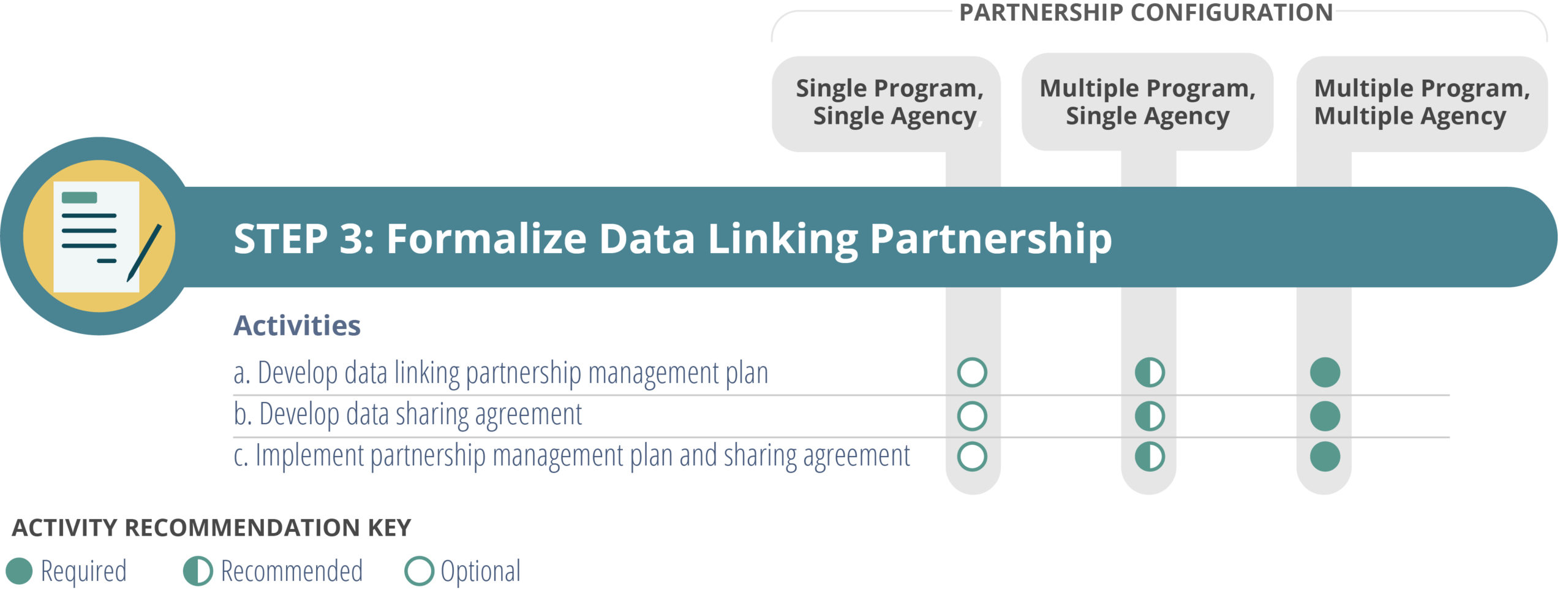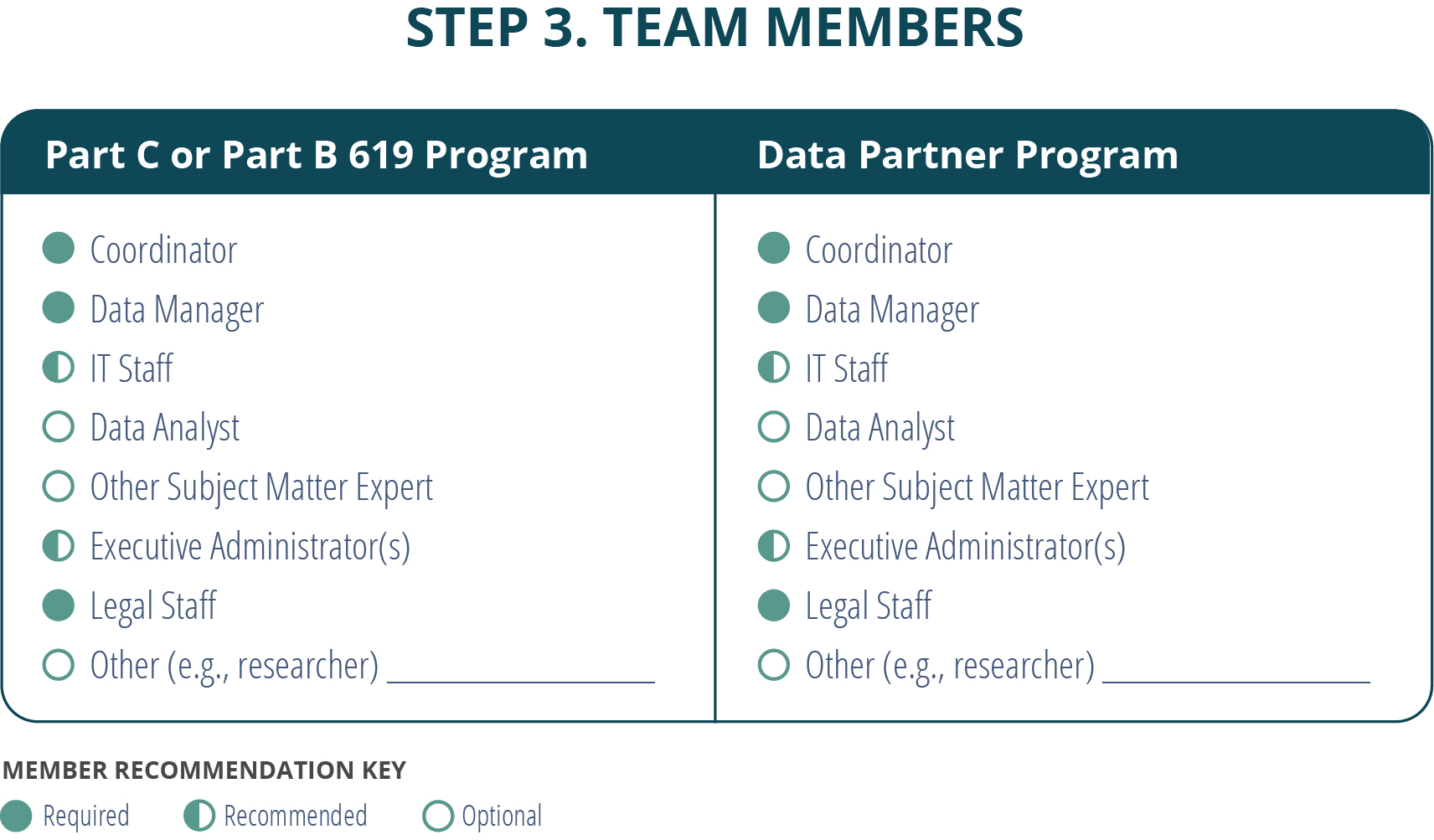| Steps to Data Linking | Step 1: Check Data | Step 2: Assess Partner Readiness | Step 3: Formalize Data Linking Partnership | Step 4: Link Data | Step 5: Analyze Data | Step 6: Sustain Data Linking |
|---|

In Step 3, data linking partners work together to establish the plan for data linking. The necessary administrative authorities establish and approve the details of the data linking activities, responsibilities, timelines, processes from beginning to end. The table below displays the roles of team members potentially involved in Step 3 activities.

After data linking partners confirm the availability of the data (Step 1) and determine that all partners are committed to and ready for the data linking partnership (Step 2), the partners need to establish joint data governance. This is done by the development and implementation of both a data linking partnership management plan and a data sharing agreement.1 Once both are developed and implemented, it is important to maintain them.
Step 3 includes multiple tools:
- a worksheet to facilitate conversation between data linking partners about expectations and processes to draft the data linking partnership management plan,
- the Data Linking Partnership Management Plan template, and
- the adapted Privacy Technical Assistance Center (PTAC) Data Sharing Agreement Checklist for IDEA Part C and Part B 619 Agencies and Programs.
While data linking partners can use these tools independently, Part C or Part B 619 program staff should contact DaSy for support if they want a facilitator or a neutral third party.
What is the difference between a data sharing agreement and a data linking partnership management plan?
A data sharing agreement is a legal document establishing the authority for agencies or programs to share, link, or integrate personally identifiable information. In addition to specific agency or program requirements, the agreement must require adherence to any related regulations (e.g., FERPA, HIPAA).
A data linking partnership management plan describes agreed-on procedures and practices to achieve the overall purposes of the data linking partnership. Unlike a data sharing agreement, a data linking partnership management plan is not a legally binding document. Therefore, it should be flexible and support process changes that do not require formal signatory approval.
Which comes first?
This depends on the agencies or programs involved. Some administrators might not approve a data sharing agreement until a data linking partnership management plan is in place. Others might not want to start the partnership management plan until all parties have approved a data sharing agreement. Starting with either document, or working on both simultaneously, is fine.
Activity 3a: Develop data linking partnership management plan
A data linking partnership management plan describes agreed-on procedures and practices to implement the data linking partnership. It is not a legally binding document and should be written to be flexible and support changes that do not require top administrators’ approval (i.e., signature). A data linking partnership management plan should reference the legal authority established through the signed data sharing agreement.
When developing a data linking partnership management plan, both partners should jointly review and discuss their respective, existing data governance policies. These data governance policies might need to be revised—with specific references or provisions related to new or updated data linking partnerships. Because existing data governance and management policies for agencies or programs are rarely designed for data linking partnerships, any joint data governance efforts must meet the minimum data management requirements of each program or agency. Therefore, a joint data linking partnership management plan is necessary. Both data linking partners should jointly develop and implement this plan to meet their respective needs and establish mutual governance of the linked data in a way that aligns with their existing agency- or program-level requirements.
DaSy recommends keeping the data linking partnership plan focused on management: tasks, responsible roles, timelines, etc. Further, we recommend keeping content requiring signatory approval out of the partnership management plan. In this way, data linking partners can update the management plan as needed without having to secure official program or agency approval. A well-designed data linking partnership management plan establishes the foundation for day-to-day practices and can promote building a culture of data use.
TIP: Program staff seeking to document their data governance policies should review the DaSy Data Governance Toolkit. The toolkit includes modifiable templates to support the creation of data governance policies specifically for Part C and Part B 619 programs.Activity 3b: Develop data sharing agreement
A data sharing agreement is a legal document establishing the authority for agencies or programs to link data. It requires all agencies or programs to follow state and federal regulations. It also sets policy between two data linking partners. Ideally, a data sharing agreement includes language outlining leadership responsibility for the review and revision of the document.
Read More +Activity 3c: Implement partnership management plan and sharing agreement
Once there is consensus on the data linking partnership management plan and the data sharing agreement, it is time to implement them. Execution of the data sharing agreement requires signatory approval from leadership and legal representatives of each partner program or agency. Shepherding the data sharing agreement through the approval process can take significant time. A change by one partner frequently—and understandably—requires a review by the other partner. Such revisions often result in organizational delays that are outside the control of those wishing to link the data.
Read More +
1Data sharing agreement is a common term. Such a document can also be developed to support data linking.
Published July 2022.

